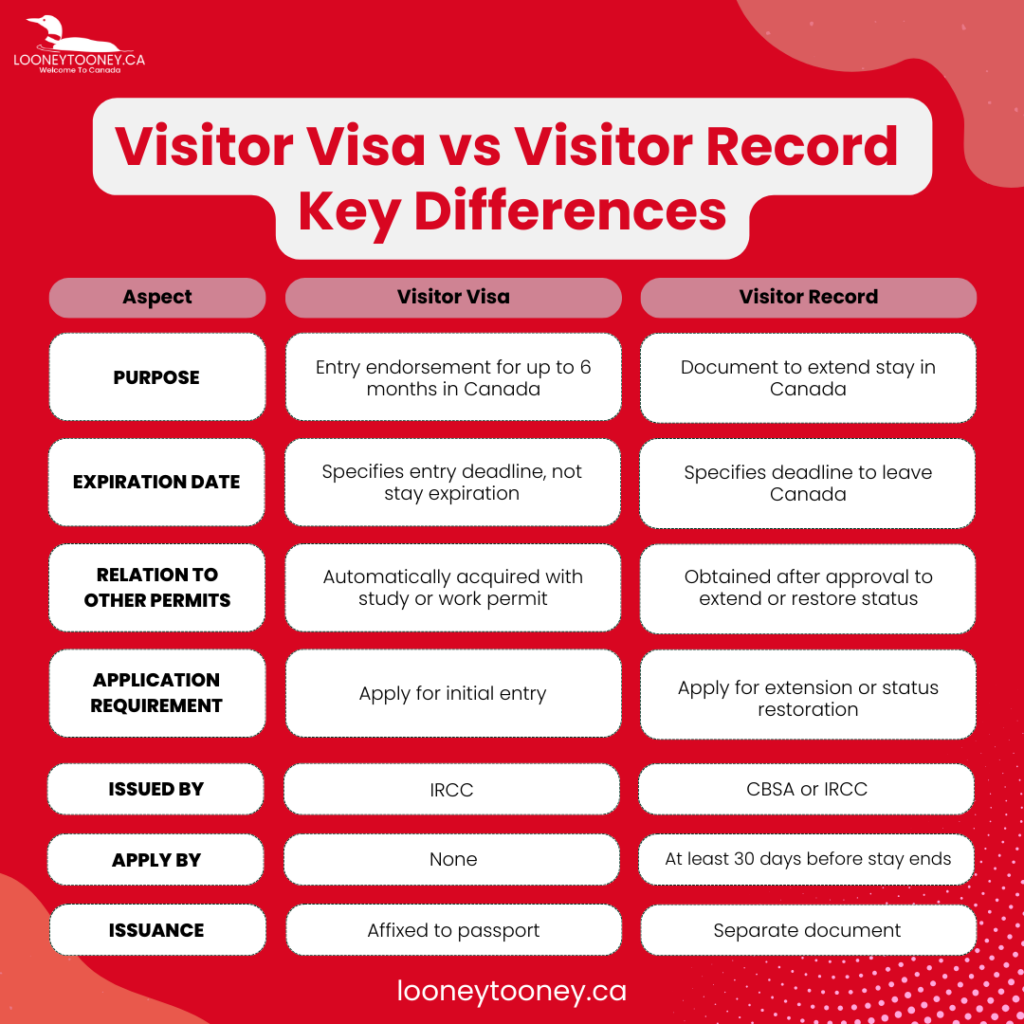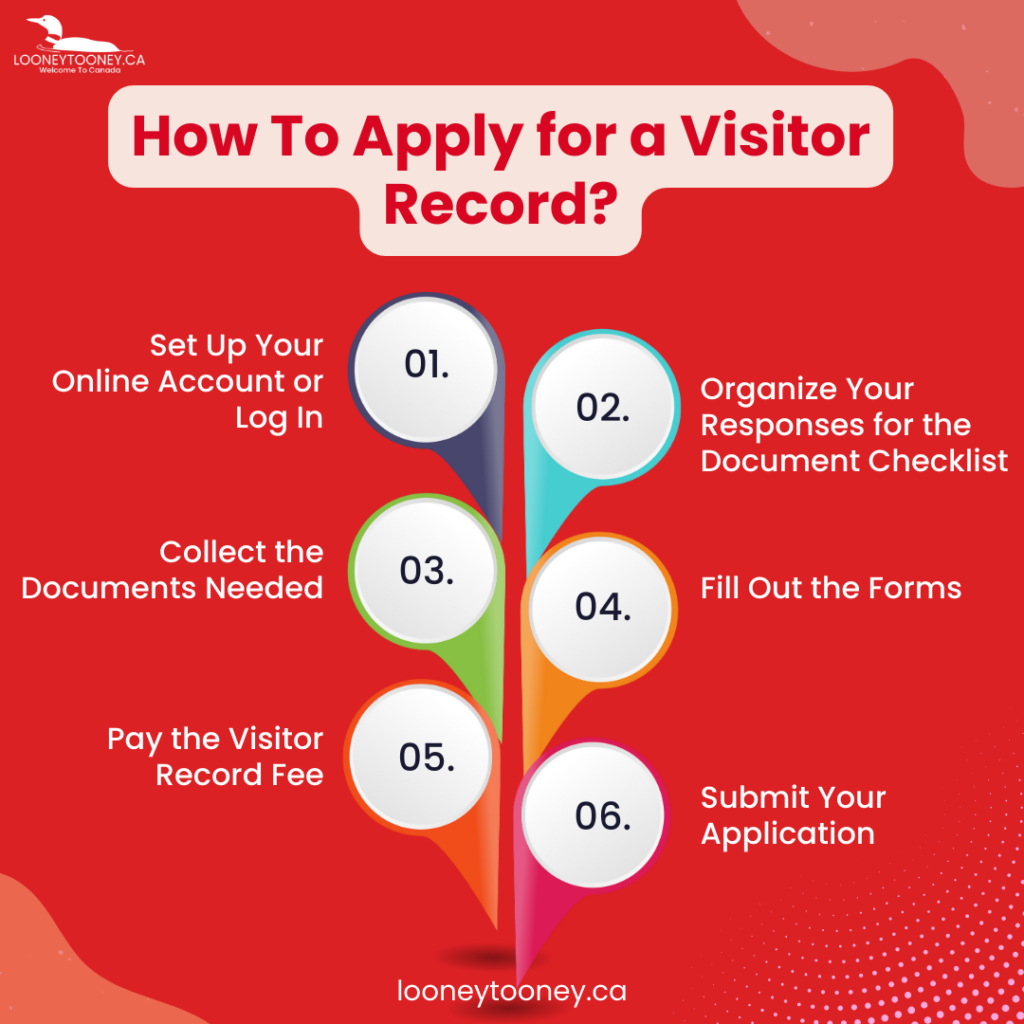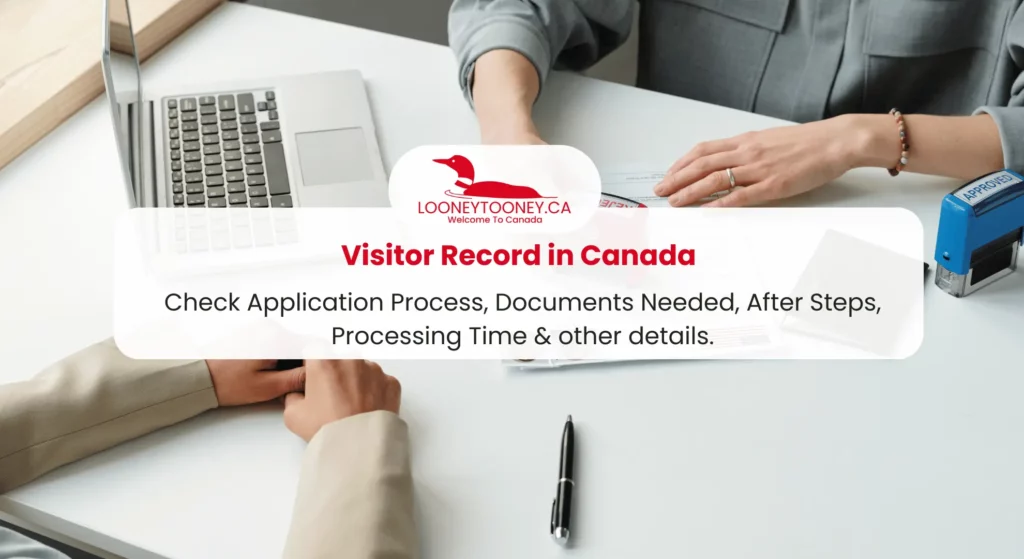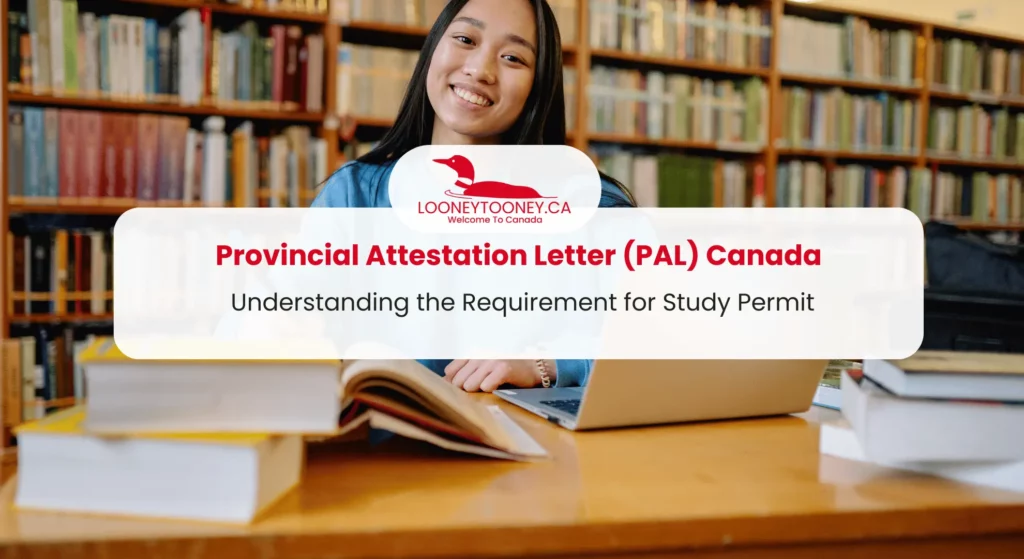Before talking about the visitor record in Canada, let us see what documents you’ll need when arriving in Canada as a visitor:
- A visitor visa in Canada also referred to as a Temporary Resident Visa (TRV)
- An electronic travel authorization (eTA)
- A valid passport or travel document
If you wish to extend your stay beyond the initial entry period, you’ll need to apply for a visitor record. It’s important to note that a visitor record is different from a visitor visa. A visitor record will let you do the following:
- Allows for an extended stay in Canada, whether as a visitor, a worker with authorization to work without a permit, or a student with authorization to study without a permit.
- Contains a new expiry date, indicating the deadline by which you must leave Canada.
A visitor record serves as a status document issued to foreign nationals, whether visa-required or visa-exempt, who seek entry to or are already in Canada. It mentions the terms and duration of their temporary stay, extending or limiting their residency and setting conditions during their visit. Additionally, it defines admission terms, specifies validity dates, and communicates the necessity of formal authorization for extending stays.
In this article, we will discuss in detail the visitor record, how to apply, documents needed and more.
Table of Contents
- When Shall You Apply for a Visitor Record Canada?
- Visitor Visa vs Visitor Record – Key Differences
- Visitor Record Canada – Eligibility Criteria
- How To Apply for a Visitor Record?
- Visitor Record Canada – After Steps
- Visitor Record Processing Time
- Travelling Outside Canada
- Visitor Record FAQs
When Shall You Apply for a Visitor Record Canada?
You should apply for a visitor record before your current status expires. If you’re uncertain about your status’s expiration date, determine your permitted duration of stay in Canada.
While a visitor record allows for a longer stay in Canada, it doesn’t automatically ensure permission for leaving and re-entering the country. If you plan to travel outside Canada or the United States, ensure you possess a valid entry document, such as a visitor visa or an eTA, to facilitate your return.
The issuance of a visitor record by the Canada Border Services Agency (CBSA) or Immigration, Refugees and Citizenship Canada (IRCC) occurs under specific circumstances.
CBSA
Upon arrival at the port of entry (POE), a border services officer (BSO) from the Canada Border Services Agency (CBSA) may grant a visitor record to a temporary resident in Canada. This issuance is prompted when the officer deems it necessary to ensure compliance with imposed conditions, such as limiting or extending the authorized stay beyond the standard 6-month period. However, the Border Services Officer at the Port of Entry can decide this based on individual cases. They may issue a visitor record that states how long a foreign national can stay in Canada.
This can mean either limiting the stay to less than 6 months or extending it beyond 6 months, but never beyond the validity of their passport. A BSO might limit a visitor’s stay if their passport will expire within 6 months if they’re a seafarer joining or leaving a crew, if they’re coming for medical treatment, or if they’ve been extradited to Canada as a temporary resident. They can also issue a visitor record if they need to verify the visitor’s departure from Canada by imposing a reporting requirement.
IRCC
When a foreign national wants to stay longer in Canada as a visitor and meets the rules, an officer from the Immigration, Refugees, and Citizenship Canada (IRCC) might give them a visitor record. This document legally extends their time as a temporary resident in Canada. An IRCC officer stationed at a case processing center may issue a visitor record to a temporary resident for various purposes. These include extending their stay in Canada beyond the initially authorized period, restoring their status as a temporary resident following its loss, or modifying the conditions of their stay.
To get a visitor record, a temporary resident should apply at least 30 days before their current status ends. They need to send an application to IRCC along with the required fee. If someone loses their temporary resident status, they have 90 days to ask for it back. If they’re approved, they’ll get a visitor record that shows how long they can stay. Usually, this is for an extra 6 months, but it can change based on the situation.
Visitor Visa vs Visitor Record – Key Differences
A visitor visa, also recognized as a temporary resident visa, serves as an official endorsement mandated for citizens hailing from visa-required nations seeking to journey to and gain entry into Canada for a duration of up to 6 months.
The issue of the visitor visa involves affixing it to the passport, serving as evidence of meeting the criteria for entry into Canada and specifying the deadline by which the traveller must arrive in the country. Notably, this date does not denote the expiration of the stay within Canada. Moreover, upon the initial application for a study or work permit, the approval thereof automatically includes the acquisition of a visitor visa.

On the other hand, a visitor record stands as a document that is given to an individual by a border services officer to either extend or restrict their tenure within Canada. If an individual wants to extend their stay beyond the initial 6 months, the border services officer has to be informed of the same.
In terms of eligibility, a visitor record is needed after the approval of applications to extend one’s stay or restore their immigration status. It is issued by either the CBSA or IRCC as mentioned above.
Application for a visitor record becomes necessary under two circumstances: upon arrival at the port of entry with intentions of extending one’s stay beyond 6 months, or subsequent decision-making within Canada to extend the duration of stay. It is mandatory to start the application process of a visitor record at least 30 days before the expiration of the authorized stay within Canada.
Unlike the visitor visa, the visitor record is a different document which is not integrated into the passport. It comes with an expiration date which is the deadline by which the individual must leave the Canadian territory.
Visitor Record Canada – Eligibility Criteria
A visitor record is suitable for individuals seeking to accomplish any of the following:
1. Extending their stay in Canada as either:
- A visitor
- An individual authorized to work without needing a work permit.
- A student with authorization to study without a study permit
2. Changing their temporary resident status to a visitor. Regardless of whether you entered Canada using a visitor visa, Electronic Travel Authorization (eTA), or another document, you require a visitor record if you intend to extend your stay in Canada as:
- A visitor
- An individual authorized to work without needing a work permit.
- A student with authorization to study without a study permit
When To Submit Your Application?
If you wish to extend your stay as a visitor or change your status (for instance, from an international student or worker to a visitor), it is advisable to apply a minimum of 30 days before the expiration of your current status.
The expiry date for your status is indicated on
- The stamp in your passport (Note: This is different from the date on your visitor visa.) If no stamp is present in your passport, the expiry date is 6 months from the day of entry into Canada.
- Your study permit
- Your work permit
How To Apply for a Visitor Record?
You must apply online for your visitor record if you are extending your stay.
Step 1: Set Up Your Online Account or Log In
Creating an account is necessary for online application submission. Your account is needed for multiple purposes, and it will let you:
- Make payments for fees
- Submit your application electronically
- Monitor the status of your application
You have the option to submit your application offline, on paper, under the following circumstances:
- If you’re unable to apply online due to a disability.
- If there’s an issue with the online application platform.
Step 2: Organize Your Responses for the Document Checklist
Before uploading your documents, the IRCC portal will ask you some questions. Your answers to these questions will generate the initial document checklist. To start with your visitor record application, first of all, provide the following responses:
- For the first query, “What is your purpose of visit to Canada?”, opt for “Visit.”
- After selecting the answer to the first query, you will get this, “Which country/territory are you currently residing in?”, choose “Canada” in that.
Step 3: Collect the Documents Needed To Apply
IMM 5558 E lists all the documents that you need to have before applying. They are as follows.
- Copies of passport pages displaying the following information clearly:
- Passport number
- Dates of issue and expiry
- Name and date of birth
- Stamp from Canadian authorities indicating your most recent entry into Canada
- Any other page
- Copies of your travel or identity document (such as citizenship certificates, birth certificates, alien registration cards, etc.) if a passport wasn’t used for entry into Canada.
- A copy of your current immigration document (if applicable).
- A copy of your marriage license or certificate is required if you are married.
- Evidence of financial support.
- Application fee payment receipt

Step 4: Fill Out the Forms
Now that your account has been logged in and you have generated a document checklist after putting the answers as stated above, it is time to fill out the necessary forms for a visitor record application.
The following forms need to be filled out:
- IMM 5708 which is an application to “Application to Change Conditions or Extend Your Stay in Canada as a Visitor”
- IMM 5476 which is for “Use of a Representative (if applicable)”
- IMM 5475 which is for “Authority to Release Personal Information to a Designated Individual”
- IMM 5409 which is for “Statutory Declaration of Common-law Union”
- IMM 5558 which is for “Document Checklist”
Step 5: Pay the Visitor Record Fee
Visitor record fees vary based on factors such as the applicant’s age, the duration of the stay extension, and whether it’s for a single applicant or a family. Currently, the fee is CAD 100 per person. Additional charges may apply for other services.
| Detail | Amount |
| Extending your stay as a visitor for one person | CAD 100 |
| Restoring your status as a visitor | CAD 229 |
| Biometrics fee of one | CAD 85 |
| Biometrics of one family (of 2 or more people) | CAD 170 |
Step 6: Submit Your Application
Make sure to complete all necessary documents accurately and attach them appropriately. Review thoroughly before submission. Follow the provided guidelines for online or paper submission. Wait for confirmation of receipt and track your application status for updates on processing.
Visitor Record Canada – After Steps
After the submission of the visitor record application, you will receive written communication if any further steps are required. Upon approval of the extension for visitor or temporary resident status, applicants will receive an immigration document. On the other hand, if the application is denied, individuals must follow the expiry date of their current temporary resident status.
For the cases where applications are rejected due to incompleteness, reapplication is necessary. If the application is referred to a local office, applicants will be duly notified and subsequently contacted by the office.
For the smooth processing of their application, applicants should ensure that all requested documentation and information are provided. Additionally, updating contact information such as mailing address, telephone number, fax number, and email address is crucial to maintain communication throughout the process.
Visitor Record Processing Time
The processing times of a visitor record vary depending on factors such as the type of application submitted, completeness of the application, anticipated processing duration for received applications, ease of information verification, response time to requests, and other pertinent factors. On average, it takes approximately 75 days to process a visitor record application.
Travelling Outside Canada
A visitor record indicates your current status and permitted stay duration in Canada. However, it doesn’t guarantee re-entry into the country. Before leaving, ensure compliance with re-entry criteria. Visa-required travellers must hold a valid visitor visa unless returning directly from the US or Saint-Pierre and Miquelon.
Visa-exempt travellers’ re-entry documentation varies based on their mode of travel. Electronic Travel Authorization holders must use the linked passport, while other travellers need a valid passport or travel document. U.S. citizens typically require a valid passport, with NEXUS and FAST members eligible for specific entry privileges based on their membership status.
In conclusion, getting a visitor record in Canada is important if you want to stay longer or change your status. Following the rules, like applying on time and knowing when your status expires, helps you go through the process smoothly and stay in Canada without any problems.
Visitor Record FAQs
Q. What is a visitor record in Canada?
A. A visitor record in Canada is a crucial document that allows individuals to extend their stay or change their temporary resident category within the country. The visitor record outlines the terms and conditions of the extended stay, including the duration and any specific permissions or restrictions imposed by Canadian immigration authorities.
Q. Can I stay in Canada while waiting for a visitor record?
A. It is advisable to apply a minimum of 30 days before the expiration of your current status if you want to stay in Canada while waiting for a visitor record.
Q. Who needs a visitor record in Canada?
A. Visitor record is needed by those who want to extend their stay as visitors; workers authorized to work without a work permit; or students authorized to study without a study permit. Additionally, those who want to change their temporary resident category to a visitor also need a visitor record.
Q. What is the processing time for a visitor record application in Canada?
A. Generally, processing times for visitor record applications is 75 days. However, applicants should regularly check the status of their application on the official website of IRCC to see if the processing is done or not.
Q. How do I get a visitor record in Canada?
A. To get a visitor record in Canada, first log in to IRCC and answer a few questions to generate the document checklist, then collect your important documents as per the checklist. Next, fill out the forms as mentioned on the portal, pay the application fee and submit your visitor record application.
Also check these,





